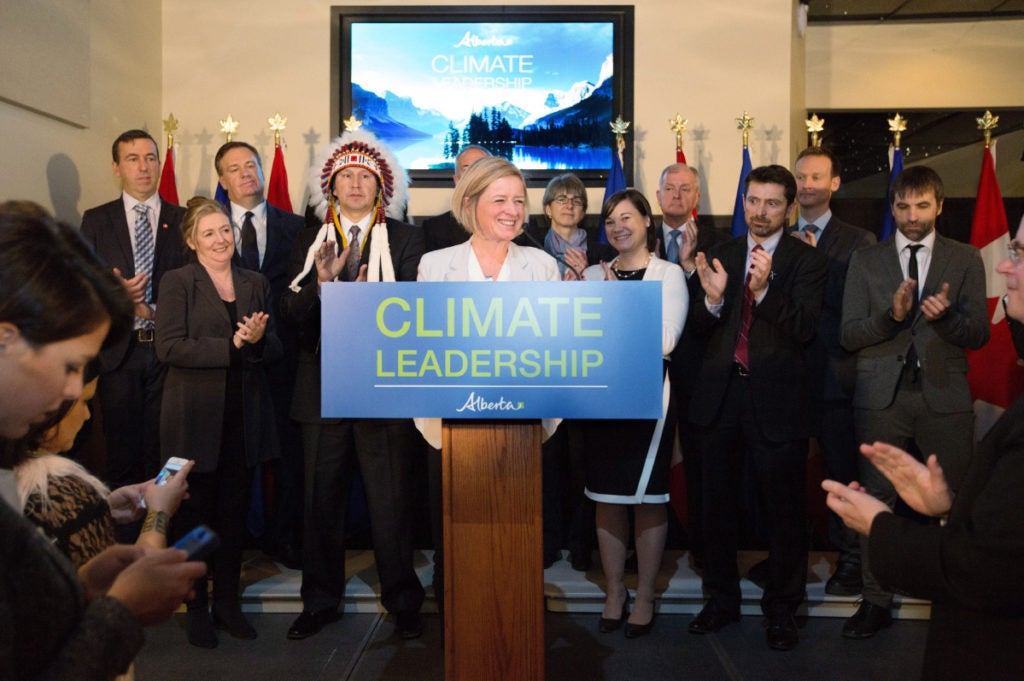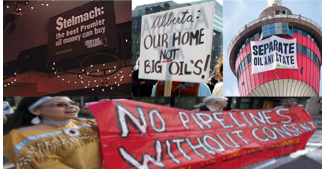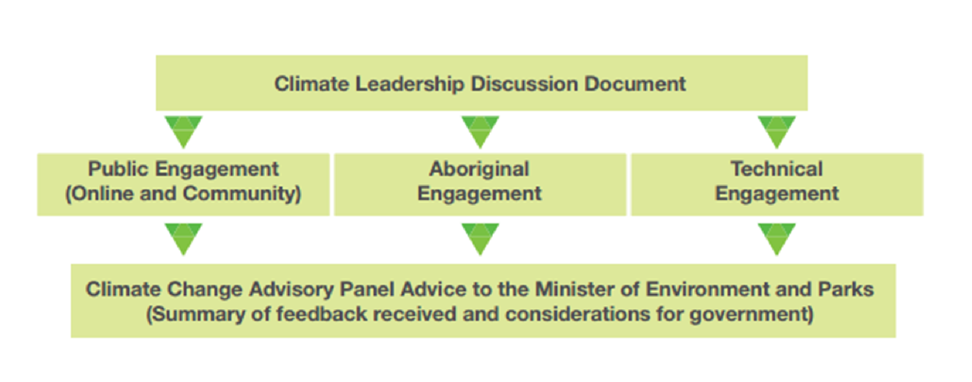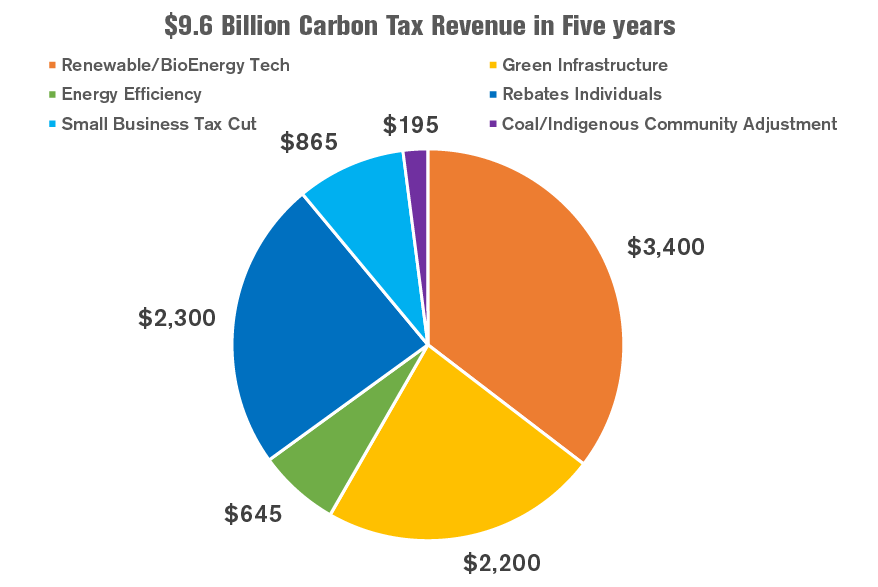Lessons from Alberta: How to Implement a Carbon Tax

Alberta passes a carbon tax and demonstrates that climate policy does not have to be a partisan issue. In this digest, we take a closer look at the process that led to the new policy.
Flushed with victory as the first to unseat Alberta’s Progressive Conservative (PC) party majority since 1971, Premier Rachel Notley of Alberta’s New Democratic Party (NDP)1 , took the stage on November 22nd 2015 for a press conference concerning the province’s new energy and climate policy, the Climate Leadership Plan (Government of Alberta 2016).
In the United States, where climate policy is a partisan issue, Premier Notley’s Plan was reported as “a radical shift in energy strategy” in line with the left-leaning political affiliation of the Premier (Lem 2016). Perhaps the shift was not that radical. As Notley mentioned in a speech at Johns Hopkins University last April, “Canada’s energy policy doesn’t take a partisan approach.” And the proof was the celebratory picture of key players endorsing the plan (see below), as well as the history and process behind it.
On the stage with Premier Notley were a diverse group of stakeholders who—at first glance—may seem more likely to be at each other’s throats concerning energy and environmental policy rather than sharing in celebration of an agreement. Representatives on stage ranged from business interests (Canada Natural Resources Limited, Suncor, Shell Canada, Pembina, and Cenovus), non-profits/non-governmental organizations (Environmental Defense Canada, Forest Ethics Canada, Clean Energy Canada, and Equiterre), and regulators (First Nations representatives as well as government leaders).

Regardless of one’s stance on the content of the Climate Leadership Plan, simply getting all these diverse interest groups to agree to anything and stand on a stage together is in and of itself an achievement and deserves careful consideration for policy makers.
This digest presents the key elements of the process to achieve the plan. Alberta could serve as a model for governments dependent on a fossil fuel economy who are looking to strike the difficult balance of exploiting fossil fuels while preserving and protecting the global climate.
The History
The November 22nd press conference was a result of over a decade of climate policy. Without previous policies, it is unlikely the NDP could have reached such a signature achievement.
In 2002 the Albertan government released a document called Albertans and Climate Change: Taking Action. The document lays out a long-term strategy to tackle climate policy and set goals to cut emissions intensity in the province. The key strategy to achieve the targets included the negotiation of binding agreements with specific sectors for the reduction of emissions and public funding for innovation and technology development related to carbon management. It is worth mentioning that this document was produced by a PC government, in one of Canada’s conservative bastions, in the middle of what would be an uninterrupted 44-year string of being in the majority in the Albertan legislature.
Five years later, the Climate Change and Emissions Management Act was approved, under another PC government. The 2007 Act took accounting of targets that had been proposed in 2002, established new targets, and focused strongly on carbon capture and storage (CCS) as a potential option to reduce emissions. Through the Specified Gas Emitters Regulation (SGER), the Act established the first carbon price in the province for large emitters who failed to meet reduction targets and a market for carbon offsets (see key points of SGER at Pachon and Weber 2016). The targets were clearly communicated, allowing time for companies to adjust. In hindsight, it seems this may have also planted the first seeds of what would eventually become the general carbon tax in the province.
While Premier Notley and the NDP deserve plenty of credit for producing a leading strategy for tackling climate change in 2016, the foundation was laid well before by previous governments. Without a clearly communicated policy vision, consistent through government change and over time, it seems unlikely the NDP—or the PCs for that matter—could have garnered the broad support needed for this initiative.
Collaboration and Partnership with Fossil Fuel Industry
Key to this plan and past plans is the collaboration and partnership with fossil fuel industry. This industry has a major role in the Alberta economy and the government has been historically supportive of it.
Since 2008, the government support translated to the establishment of private-public partnerships to actively pursue (and pay for) CCS and a variety of other innovative carbon-reduction projects (Figure 2). Funding for the projects comes from the fee that large emitters pay when they fail to meet their emission intensity targets. Thus, the carbon payments get re-invested in the sector. The Climate Change Emissions Management Corporation (CCEMC) administers those funds.

This has not meant that Alberta is simply handing out cash or sopping to industry. The public-private partnership agreements were structured in such a way as to require industry to put up much of the up-front costs for research and feasibility, as well as construction. The government funding becomes unlocked once a project is demonstrably achieved. This approach insures that when projects fail, the taxpayers and the government do not end up footing the bill.
Striking a Balance by Limiting Regulatory Capture
Even though Alberta was one of the first jurisdictions in North America to introduce a price on carbon—something oil and gas producing states in the U.S. are still far from considering—oil sands production expanded, as did the “resource’s dirty reputation” (Markusoff 2016). The policies and regulations targeted to reduce large emitter’s emissions intensity had modest results. For environmental groups and aboriginal communities, Alberta’s “poor environmental record” was the result of the “laxity” of the PC government with the oil and gas industry concerning environmental regulation (Whittingham 2015, Steward 2015). In 2013, the appointment of Gerry Protti as the Chairman of the Alberta Energy Regulator (AER)—the provincial agency in charge or regulating wells, pipelines, oil sands, and coal mines—caused outcry (Calgary Herald 2015). Prior to the AER appointment, Protti was an oil company executive and president of the Canadian Association of Petroleum Producers, the lobby arm of the sector. His appointment was seen as a proof of regulatory capture.
As leader of the NDP, Premier Notley was very critical of this appointment and outspoken about the need to improve the province’s environmental record. Her election meant the end of the PC era and, most likely, the limitation of the industry’s influence in political and regulatory decisions.

Once elected, however, she did not fire Protti, who has since his appointment made efforts to establish a model of regulatory excellence for the AER (AER 2016). Instead, Notley led the enactment of legislation banning donations to political parties from corporations and unions, and more legislation is underway concerning a review of conflict of interest and whistleblower laws (Kleiss 2015). These actions have given Notley the credibility with non-industry stakeholders, who saw in the climate plan process an opportunity to “turn the page on Alberta’s poor environmental record” (Whittingham 2015). At the same time, Notley has reinforced her support for the oil and gas industry, talking openly about how important the sector is for Alberta’s economy. She considers it a priority to gain approvals to build new pipelines that will allow the province to reach new export markets and has advocated for the Energy East oil sands pipeline (Osman 2016), which has been fiercely opposed by environmental groups and First Nations communities.
Consulting with the Public and with Experts
In the summer of 2015, the newly appointed government designated an advisory panel to undertake a comprehensive review of existing climate policies, to consult with stakeholders and to provide advice to establish a broad climate change strategy. The panel was chaired by Dr. Andrew Leach, an energy economist at the University of Alberta. The panel heard a wide range of stakeholders and produced a report providing recommendations to the government. The climate leadership discussions, provided a unique opportunity for stakeholders to contribute and discuss policy options. Citizens, regulators, NGOs, businesses, and sector experts were all intimately involved with the process.

Technical engagement sessions were held with the various industries and environmental groups directly affected by new energy policies. From the summary document of the technical engagement sessions, it seems clear these engagement processes were far from formalities—in particular the prospect of a broad carbon fee was specifically raised in four of the eight technical engagement sessions and in many of the public comments from open houses—the policy found itself in the final recommendations (Alberta Environment 2015).
Interestingly, in the technical engagement sessions from the oil and gas sector it was also noted that credibility of the oil sands industry with regards to environmental compliance in Alberta was a major concern for the sector. This is not surprising. In the last year, two major projects—Keystone XL and Northern Gateway—were overturned after seven and ten years of approval processes, respectively. It is not implausible to believe such public fights over the environmental impact of the oil sands production have caused concern in oil producers that future markets may be more difficult to access without a reputation for environmental excellence. It appears Alberta’s largest fossil-fuel companies are acutely aware of, and willing to partner in policy to improve their public image on environmental stewardship.
Transparency
The proposed changes to climate policy meant non-trivial costs to Albertan energy consumers. Cost estimates for the carbon fee range from $300-$1000 in additional annual costs to average Albertans. These costs and alternative options were discussed with the stakeholders. Open house sessions provided an opportunity for Albertans to submit comments and suggestions on proposed policy before the advisory panel provided its advice to the Ministry of Environment and Parks. The Albertan government has transcribed all the comments and posted them online for viewing.
It is worth noting that despite the disclosure and debate over the carbon tax costs, other indirect costs were not included in the discussion—like costs that large emitters could pass to customers to achieve compliance of SGER regulations or higher electricity rates resulting from the phasing out of coal plants and the adoption of cleaner technologies.
In the first case, there was no need to include these costs in the discussion. Costs incurred by large emitters to comply with SGER regulations are not likely to be passed to Alberta citizens, as they are tax deductible.
The debate over higher electricity rates will certainly happen later, when the government is going to define a plan to phase out coal generation.
Achieving Compromise: Something for Almost Everyone
Taking the advice of the advisory panel, the carbon tax was officially passed in the legislature as Bill 20 last June. The tax is scheduled to begin implementation on January 1, 2017. The tax does not include large emitters; those will continue to be subject to SGER, which was updated in 2015 to increase their carbon intensity targets and the fee.
Only a single amendment was passed among dozens of proposals. The opposition blamed the NDP of “wielding its majority like a hammer” and of failing to properly study and communicate the economic effects the tax would have on consumers during discussion of the bill and its amendments (Alberta Hansard 2016).
Despite the criticism, the bill represents a compromise for most parties.
Large emitters—mainly the fossil-fuel industry—will have to curb emissions and pay a higher fee (up to $30/tonne of CO2) if they fail to do so. In the absence of the tax, the onus was on large emitters only, to reduce emissions. The tax represents a broad-based, society-wide effort to fight a global problem. A potentially improved public opinion of the tar sands’ environmental reputation and the part it is playing in fighting climate change could even end up benefiting the industry.
For environmental groups advocating for the partial de-carbonization of the economy, the tax is a compromise that will allow compensation for environmental harm while providing incentives to reduce fuel consumption and emissions. It could be another step towards de-carbonization. In addition, the increase of the carbon price paid by large emitters and the cap on emissions from the tar sands represents stricter obligations for the fossil fuel industry and will require real commitment to carbon reduction on the part of major emitters.
For the renewable energy industry, the Climate Leadership Plan allocates more than a third of the revenues from the carbon levy in the next five years—$3.4 billion out of the $9.6 billion—to large scale renewable energy, bioenergy, and technology projects. Combined with higher costs for fossil-fuels, renewable energy may come out a major winner from the new plan.
For consumers, there will be direct and indirect costs, as mentioned previously. The tax is not totally revenue neutral as originally proposed and is necessarily regressive as energy expenditures represent a higher share of the income of poorer households. However, the bill establishes rebates to compensate low income customers; $2.3 billion will be reimbursed to households to assist with the costs of the tax in the next five years. The total expected revenue from the tax in the next five years will be distributed as shown in figure 5.

Though the tax adds cost to consumers regardless of oil prices, depressed gas prices might make additional taxes on gas easier to bear and make the transition to paying more for energy smoother than a high oil price scenario.
Under existing regulations, 12 out of 18 coal-fired generating units had planned shut downs before 2030. The tax will certainly accelerate this phase-out and part of the climate plan not yet codified in law will force the shutdown of the other six plants, making coal power producers the main losers from the change. The province is working with the remaining six coal power generators to determine the process to phase them out.
The Main Lesson
Alberta’s process may not be a perfect match for the United States. Alberta has a population of just over 4 million and the number of major energy companies with which to engage is far more limited than in the United States; reaching out to all stakeholders and achieving consensus is simply easier with fewer parties to account for and fewer climate change deniers who question the validity of anthropogenic climate change2 . However, policy discussions occurring at the federal, state, and local levels could benefit from considering the success of the Climate Leadership Plan process.
The main lesson from this process is the demonstration that climate policy does not have to be a partisan or ideological issue. Achieving compromise on climate matters is possible, but it requires, among other factors, a long-term and consistent policy, an inclusive process, transparency, collaboration with the fossil fuel industry and at the same time, the limitation of regulatory capture. This implies developing a system that attempts to create workable solutions for all stakeholders, not just for a single interest group.
In some contexts, the regulation of one or only a few sectors may facilitate the implementation of environmental policy. Involving many sectors can introduce complexity and limit the risk to achieve agreement. This was not the case of Alberta. As proven by its experience, in Alberta, getting buy-in from a broad range of important constituencies moved the policy forward. Imposing the tax or levy to all sectors in the economy was key for such buy-in. It took Alberta a third round of climate policies to include all sectors, even though, the current plan is not a complete level playing field, as regulation for large emitters remains outside the general carbon tax. But by covering all sectors, emissions could get reduced in a more substantive way and chances of acceptance and willingness to pay the tax increase. In the U.S. this could be a key element to reduce the perception that governments will use climate policy “to reward friends and hurt adversaries” (Flavelle 2016).
Angela Pachon
Special AdvisorAngela Pachon is a special advisor the Kleinman Center and was previously the Center’s research director. She advises on the research agenda, research grants and the visitor scholar programs, as well as developing scholarship and research collaborations.
Dillon Weber
Research AssistantDillon Weber was a research fellow at the Kleinman Center and a graduate of the University of Pennsylvania majoring in chemical and biomolecular engineering and economics.
Alberta Climate Leadership Discussions: Report from Online Engagement. Edmonton, AB: Alberta Environment, 2015.
Alberta Climate Leadership Discussions: Technical Engagement Summary. Edmonton, AB: Alberta Environment, 2015.
“Alberta Election: NDP Surges to Majority Government.” Calgary Herald, May 6, 2015.
http://calgaryherald.com/news/politics/alberta-election-latest-results.
Alberta Environment. Albertans and Climate Change Taking Action. Edmonton, AB, 2002.
“Alberta Hansard.” 29th Legislature, Second Session. Day 40. (June 7, 2016).
“Climate Change and Emissions Management Act, Specified Gas Emitters Regulation”, Alberta Regulation 139/2007, with amendments up to and including Alberta Regulation 199/2015: Province of Alberta 2007 and 2015
Bellefontaine, Michelle. “Rachel Notley and the NDP: Fresh Faces or Ruin of Alberta?” CBC News, May 4, 2016.
http://www.cbc.ca/news/canada/edmonton/rachel-notley-and-the-ndp-fresh-f….
“Best-In-Class Project.” Alberta Energy Regulator.
https://www.aer.ca/about-aer/spotlight-on/best-in-class-project
“Bill 20: Climate Leadership Implementation Act”, Alberta Legislature, Royal Assent June 13, 2016
http://www.assembly.ab.ca/net/index.aspx?p=bills_status&selectbill=020&l…
“Climate Change and Emissions Management Act: Specified Gas Emitters Regulation”, Public Law139/2007, (2007). http://www.qp.alberta.ca/documents/Acts/C16P7.pdf
“Climate Leadership.” Climate Leadership Plan, Government of Alberta.
http://www.alberta.ca/climate.aspx
Flavelle, Christopher. “Obama Shows How Not to Sell a Carbon Tax.” BloombergView, February 12, 2016.
https://www.bloomberg.com/view/articles/2016-02-12/obama-shows-how-not-t….
“He Knows How the Premier Feels about Him, but Gerry Protti Would like to Stay as Head of the AER.” Calgary Herald, June 14, 2015. http://calgaryherald.com/storyline/he-knows-how-the-premier-feels-about-….
Kleiss, Karen. “Government Committee Will Review Elections, Ethics Laws.” Edmonton Journal, June 25, 2015.
http://edmontonjournal.com/news/politics/government-committee-will-revie….
Lem, Pola. “Canada: Alberta Premier Says Industry Key to Taxing Carbon.” ClimateWire, April 29, 2016. http://www.eenews.net/climatewire/stories/1060036480/search?keyword=Canada: Alberta premier.
Markusoff, Jason. “Shannon Phillips: Alberta’s Minister of Hard Hits.” Maclean’s, January 11, 2016.
http://www.macleans.ca/news/canada/shannon-phillips-albertas-minister-of….
Osman Pola. ” Premier Rachel Notley rallies Alberta mayors in support of Energy East pipeline.”CBC News, Edmonton, March 9, 2016. http://www.cbc.ca/news/canada/edmonton/premier-rachel-notley-rallies-alb…
Pachon, Angela and Weber Dillon: “ Taxing the Tar Sands” , Kleinman Center for Energy Policy, August 10, 2016. http://kleinmanenergy.upenn.edu/policy-digests/taxing-tar-sands
Steward, Gillian. “First Nations Bear the Risks of Oilsands Development.” The Star, August 28, 2015. https://www.thestar.com/news/atkinsonseries/2015/08/28/first-nations-bea…
“What we heard.” Climate Leadership Plan, Government of Alberta. http://www.alberta.ca/climate-leadership-discussion.aspx
Whittingham, Ed. “New Provincial Government Could Turn the Page on Alberta’s Poor Environmental Record.” May 7, 2015. https://www.pembina.org/blog/new-provincial-government-could-turn-page-o…
- While the Progressive Conservative party represents moderate conservatives who are in the center-right between the traditional Conservative party and the Liberals, the New Democratic Party is a center-left party, with an agenda similar to the Liberals. [↩]
- Online survey results made during the consultations showed large support from Albertans for climate policies. Nearly 70% of respondents indicated they supported greater action by the government on climate change. Furthermore, over 60% of respondents indicated support for a phase-out of coal-generated electricity and 40% of respondents said they would be willing to support climate policies that resulted in additional personal costs. [↩]


